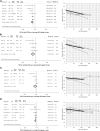Consumption of nuts and legumes and risk of incident ischemic heart disease, stroke, and diabetes: a systematic review and meta-analysis
- PMID: 24898241
- PMCID: PMC4144102
- DOI: 10.3945/ajcn.113.076901
Consumption of nuts and legumes and risk of incident ischemic heart disease, stroke, and diabetes: a systematic review and meta-analysis
Abstract
Background: Relations between the consumption of nuts and legumes and risk of ischemic heart disease (IHD), stroke, and diabetes have not been well established.
Objective: We systematically investigated and quantified associations of nut and legume consumption with incident IHD, stroke, and diabetes.
Design: We systematically searched multiple databases to identify randomized controlled trials or observational studies that examined the relations. Studies were excluded if they reported only intermediate physiologic measures, soft cardiovascular outcomes, or crude risk estimates. Data were extracted independently and in duplicate. We assessed pooled dose-response relations by using a generalized least-squares trend estimation, and prespecified sources of heterogeneity were assessed by using metaregression. The potential for publication bias was explored by using funnel plots, Begg's and Egger's tests, and Duval and Tweedie trim-and-fill methods.
Results: Of 3851 abstracts, 25 observational studies (23 prospective and 2 retrospective studies) and 2 trial reports met inclusion criteria and comprised 501,791 unique individuals and 11,869 IHD, 8244 stroke, and 14,449 diabetes events. The consumption of nuts was inversely associated with fatal IHD (6 studies; 6749 events; RR per 4 weekly 28.4-g servings: 0.76; 95% CI: 0.69, 0.84; I(2) = 28%), nonfatal IHD (4 studies; 2101 events; RR: 0.78; 0.67, 0.92; I(2) = 0%), and diabetes (6 studies; 13,308 events; RR: 0.87; 0.81,0.94; I(2) = 22%) but not stroke (4 studies; 5544 events). Legume consumption was inversely associated with total IHD (5 studies; 6514 events; RR per 4 weekly 100-g servings: 0.86; 0.78, 0.94; I(2) = 0%) but not significantly associated with stroke (6 studies; 6690 events) or diabetes (2 studies; 2746 events). A meta-regression did not identify the effect modification by age, duration of follow-up, study location, or study quality. Mixed evidence was seen for publication bias, but analyses by using the Duval and Tweedie trim-and-fill method did not appreciably alter results.
Conclusion: This systematic review supports inverse associations between eating nuts and incident IHD and diabetes and eating legumes and incident IHD.
© 2014 American Society for Nutrition.
Figures



Comment in
-
The plausible health benefits of nuts: associations, causal conclusions, and informed decisions.Am J Clin Nutr. 2014 Jul;100(1):8-10. doi: 10.3945/ajcn.114.090431. Epub 2014 May 28. Am J Clin Nutr. 2014. PMID: 24871473 Free PMC article. No abstract available.
References
-
- US Department of Agriculture and US Department of Health and Human Services. Dietary guidelines for Americans. 7th ed. Washington, DC: US Government Printing Office, 2010. - PubMed
-
- Estruch R, Ros E, Salas-Salvadó J, Covas MI, Corella D, Aros F, Gomez-Gracia E, Ruiz-Gutierrez V, Fiol M, Lapetra J, et al. Primary prevention of cardiovascular disease with a Mediterranean diet. N Engl J Med 2013;368:1279–90. - PubMed
-
- Kelly JH, Jr, Sabaté J. Nuts and coronary heart disease: an epidemiological perspective. Br J Nutr 2006;96(suppl 2):S61–7. - PubMed
-
- Stroup DF, Berlin JA, Morton SC, Olkin I, Williamson GD, Rennie D, Moher D, Becker BJ, Sipe TA, Thacker SB. Meta-analysis of observational studies in epidemiology: a proposal for reporting. Meta-analysis Of Observational Studies in Epidemiology (MOOSE) group. JAMA 2000;283:2008–12. - PubMed
Publication types
MeSH terms
Grants and funding
LinkOut - more resources
Full Text Sources
Other Literature Sources
Medical
Miscellaneous

